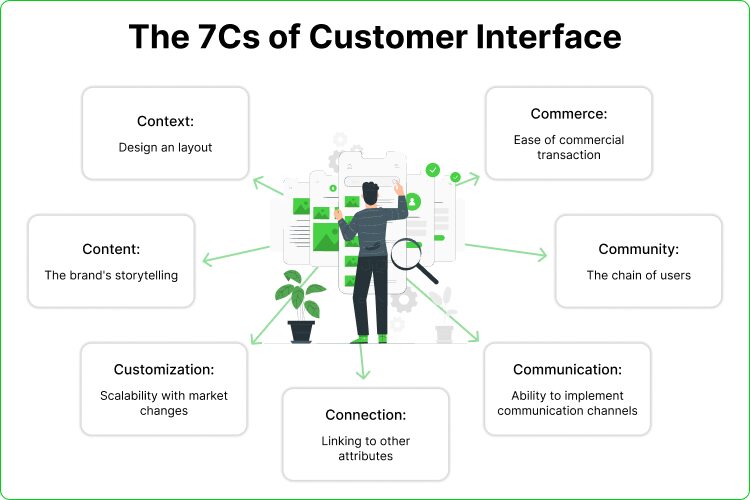 Customer Service
Customer Service

11 January, 2024

The power to elevate business growth not just lies in selling products or services, but in the connection, you build with the people who matter the most- Your Customers. And that’s the point, the term empowerment of customer interfacing enters.
It is a way or media a business interacts with its customers via a web-based or any other technical platform. An effective interface personalizes the experience and offers relevant options and information according to the customer’s needs.
This overall process promotes exceptional customer service and experiences.
And here is the kicker:
For every 1% increase in customer satisfaction, you can expect an average 5% increase in customer retention rates. Even according to a study, up to 96% of customers leave a brand just due to poor customer service.
So, the query relating to the power of customer interfacing should be clear now. If not, stick by me till the end. In this new guide, I’m here with a complete breakdown of customer interfacing.
Contents

Suppose, you’ve navigated to a mobile banking app where you get an intuitive platform featuring different segments. These allow you to check your balance, transfer funds, pay bills, and manage your accounts with just a few taps.
This is a customer interface through which you interact with the software system.
So to make it short, a customer interface is a business model that facilitates the way in which the firm interacts with its audiences. Think of it like a platform featuring all those things that the customers can view, read, click, watch, or share to better understand the brand.
As per the experts, it is an entrance where business communicates with customers as individuals which is the root of customer experience management.
Customer interface plays a crucial role in building more personalized experiences for the customers towards that specific brand. This shapes the business by including an effective user interface, excellent customer service interactions, self-service options, and overall brand communication.
This can result in increased sales, positive word-of-mouth marketing, and sustained business growth.
Even according to a 2003 survey by Genex, the purchasing intentions of online consumers are impacted by the customer interface. And most important, up to 65% of business-to-consumer (B2C) shoppers are discouraged from using websites with inadequate customer interfaces.
Let’s clear out the fact why establishing a good customer interface is a like drug for your business life:
A well-designed and responsive customer interface is enough to provide a seamless user-friendly interaction, address the user’s needs, and ultimately ensure a positive experience for them.
A user-friendly interface that simplifies transactions provides easy access to information, and resolves issues promptly encourages customers to come back again and again. This helps you to build business loyalty and increase the lead.
A strong customer interface can make you stand out among the vast competitors by improving operational efficiency, reducing costs, or providing a seamless and enjoyable experience to the users.
Here’s a live example:
Just look at the most famous lifestyle brand Anthropologie, and you will easily understand what I mean. It creates an immersive experience for customers by curating a lifestyle that goes beyond just selling products.
Every retail store is designed to inspire and drive visitors into an aspirational world through sounds, scents, and visuals. This approach sets Anthropologie apart, making it more than just a place to shop but a customer connection.
A strong interface creates positive interactions that strengthen your brand in the marketplace. Poor interfacing can damage your reputation.

If you’re reading the term Customer interface you might know about 7Cs describing this fact. Basically, in 2001, Rayport and Jaworski introduced the seven designed elements to virtually represent this firm.
For any website interface that is intended for sales and commerce, these elements are essential to drive traffic and create positive end-to-end customer experiences across any channel from first interaction to support.
Here is the breakdown:
In the context of customer interface, the term “Context” mainly refers to the visual designs and layouts of a website.
It should be simple, easy to navigate, and quite user-friendly which every visitor desires how it should be.
For example, you can see the most popular clothing brand RALPH LAUREN.
Here you will find every section easy to use for the individuals where they can find anything of their preference with just a click.
The term perfectly goes if you have a brand regarding sales or commercial transactions. If it is really you, make sure, each of the commercial navigations like transaction and product selection points is clear enough that customers can directly order without any distractions. Ralph Lauren’s website is a live example for it that implements this C of 7Cs in an appropriate way.
Here content is mainly of your website that you want to represent your customers.
No matter, whether it is in text, pictures, sound, or video form, it should deliver clear and concise information. Most importantly focus on personalization that would reflect relevancy to your customer’s interests, preferences, and needs.
Even 89% of popular businesses like Coca-Cola, Netflix, or USAA are investing a lot in personalization to increase digital customer engagement.
Current businesses are running through user-to-user communication systems. The interface may contain message boards or even live chatbots to interact with the customers 24/7 for their queries.
If it is an e-commerce business, then this C is the most important term to implement. It would be like a personal area for each visitor where they allow them to select and customize terms according to their color, size, logos, and design choice.
Every brand needs to build effective communication with its customers through different channels. You can use digital media for quick customer management.
Marketers can leverage different media channels in the customer interface like email, social media platforms, or phone numbers to interact with them.
Not just visually, fostering engagement emotionally is another marketing strategy for today’s brands.
Actually, it works:
According to Spiralytics, up to 71% of customers like to interact with a brand that cares about their emotions.
Customer interface elements mainly refer to all the touchpoints through which a customer will interact with your products. It will provide all the information about your services in such a strategic way that customers can easily get through it.
Though effective customer interface management comprises lots of things, here I am listing some major ones that you must have:

Customer Centric Strategy
It is the key component of building a customer interface. This involves prioritizing the needs and preferences of your customers through the designs and implementation of the interface.
This approach will guide you to create a seamless and personalized experience for the customer, ultimately fostering their satisfaction, retention, and revenue.
Intuitive Navigation
Navigation is a critical part of the customer interface. This is why it directly impacts the user experience and the ability of the customer to complete a task.
Want to know the best part?
Clear and intuitive navigation is boosting dose to get customer satisfaction. It enhances the usability of your customer interface, making it easier for customers to locate your products, services, or information.
Well-optimized Content
We’ve already discussed the importance of engaging content to make an effective customer interface. It is a fundamental component of an interface that is what customers want to see or hear from you.
But if you just think your content will work the same today as yesterday, then you might as well pack yourself and go back home.
You need to always customize it and make it personalized using the customer data to make it always relevant and valuable.
Naomi Karten in her book “Managing Expectations, Working with People Who Want More, Better, Faster, Sooner, NOW!” states three terms: Communication, Information gathering, and Practices to enhance and promote good customer interfacing.
That means you will need to listen to your customer’ first, communicate with them to learn their needs, and lastly them into realizable deliverables,
Beyond that, she mentioned a few more guidelines that could be applied as a habit of good customer interfacing skills. Let’s have a short glimpse at all of them:
Looking for some effective SaaS interfacing tools to help your SaaS business run moon and back? Here is the list of the top 5 SaaS tools for customer interfacing, with the optimal use case, feature, and pricing model:

Qualaroo is one of the best customer feedback tools suitable for implementing an effective customer interface for your business.
This is an excellent SaaS tool, suitable for small businesses and startups which you can use for different levels of customer engagement based on their actions on a website.
For instance, you’ll get a bunch of advanced customer service features at an affordable cost. Different templates are the best ones that let you create personalized and contextual surveys by asking questions.
These insights help users engage with customers by prioritizing their needs.
Key Features:
Price: Offers different packages starting at $69 per month.
Looking for effective and easy-to-operate Customer engagement Tools through building robust customer support? Zendesk would be the best platform to start with.
It is the best customer service platform with a clouding system that provides a user-friendly interface for customers to track their queries.
Here you will get a ticketing system through which you can connect support teams with your customers across different channels like email messaging, Slack, Microsoft Teams, forums, or chat.
Plus the analysis and report will give customer insights that help businesses make informed decisions.
Key Features:
Price: Starts with $49/per agent
SurveyMonkey is now almost leading the market as the top-class customer insight tool for the SaaS business. Their interface is quite clean and straightforward, still for all individuals for easy and quick access.
All the advanced segments allow you to track down the feedback from customers or conduct market research for deep analysis in a few seconds.
Plus the Global Survey Panel of this tool is superior in that it helps you connect customers from multiple ways.
Key features:
Price: Start with $25. Free version available.
Slack is an advanced communication tool, highly used by most SaaS businesses to interact internally in a company.
It comprises an enhanced live chat room that facilitates advanced internal and external team collaboration in real-time.
You can even share files and messages in the live chat room. With a built-in video call and phone facility, you can switch your conversation to calling as well.
Key features:
Price: Starts from $2.67/month
If you are a SaaS business owner, HubSpot should be a quite known term for you. The best part is you can utilize this customer interfacing technology to achieve your customer engagement goals.
This offers a whole package to establish a good customer interface, starting from SEO, content marketing, traffic analysis, customer support, social media marketing, etc in a single platform.
Key features:
Price: Starts at $45/month
Well, that’s all here today about customer interfacing. It is nothing but a roadmap for building interaction between a business and its customers across various touchpoints and channels. Effective customer interfacing ensures a seamless, consistent, personalized experience that leads to building strong customer relationships and loyalty.
This requires a proper optimization of contents, platforms, and processes based on the customer’s perspective.